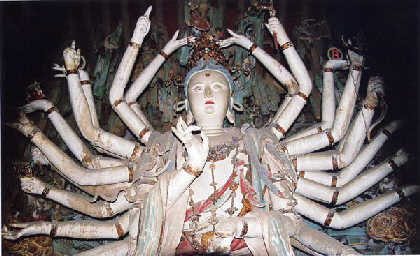
Shuanglin Temple, located in Qiaotou Village six kilometers southwest of the old town of Pingyao, Shanxi Province, was first built in the early years of the Northern Wei Dynasty (386-534 AD) and later destroyed during wars. It was rebuilt during the Song Dynasty (960-1279 AD) and existing structures and statues were mostly made in the Ming-Qing period (1368-1911).
Shuanglin Temple, facing the south, stands on a 3-meter-high earth terrace and covers an area of 15,000 square meters. The temple consists of two sections, with a total floor space of 3,711 square meters. The west section is composed of ten halls in three courtyards where Buddhist deities are enshrined, while the east section consists of meditation abodes and Buddhist sanctuaries. An enclosure wall made from rammed earth encompassed the temple during the Ming Dynasty, which made the whole structure look like a small fort. Outside the temple is a music tower which is symmetrically and neatly laid out.
Shuanglin Temple boasts such rare national treasures as Chinese scholar trees planted in the Tang Dynasty, stone tablets carved in the Song Dynasty, copper bells made in the Ming Dynasty as well as exquisite wood buildings, painted statues and mural paintings. In particular, its 2,000-odd painted clay statues are considered the top best. Those Ming-dynasty painted sculptures integrate stalls and styles of previous dynasties and highlight the realistic styles, thus bringing the temple the reputation as the "treasure house of painted sculpture art in the East". Those Buddhist statues are all well designed and vividly carved, with their heights ranging from dozens of centimeters up to 4 meters. Both Buddhist and mundane figures were made out of traditional wood molds.